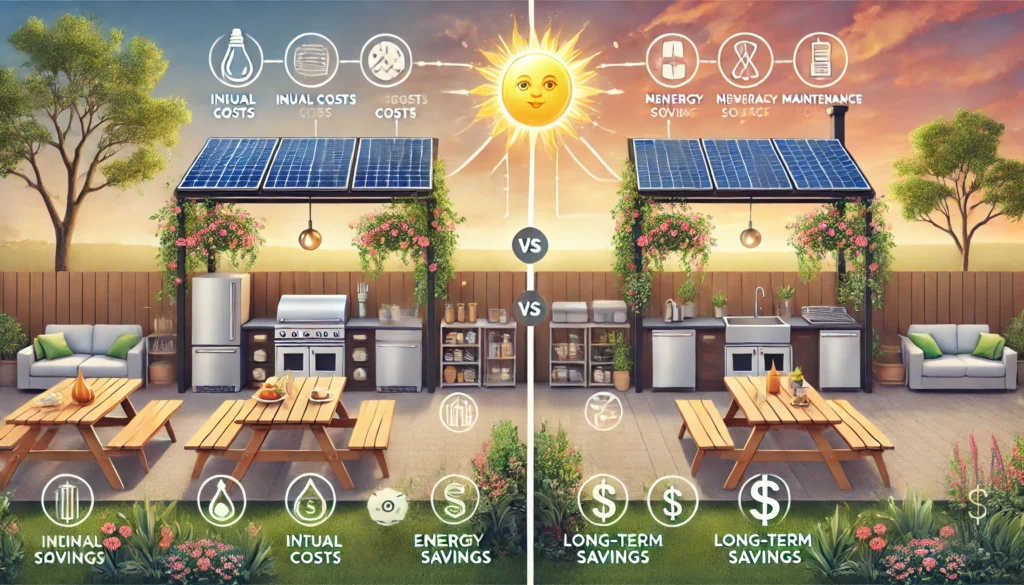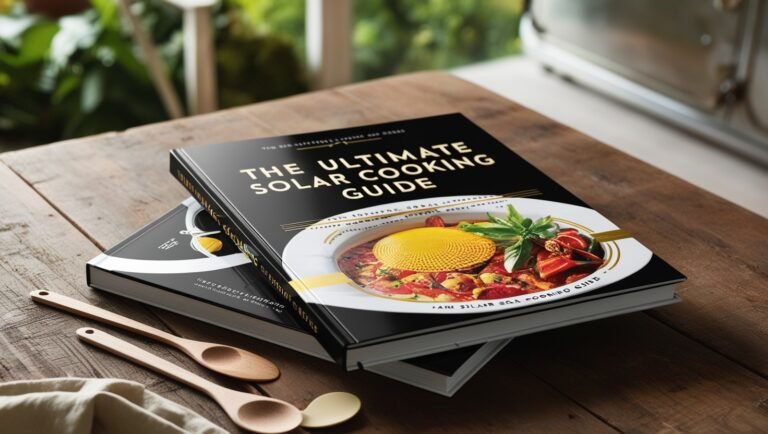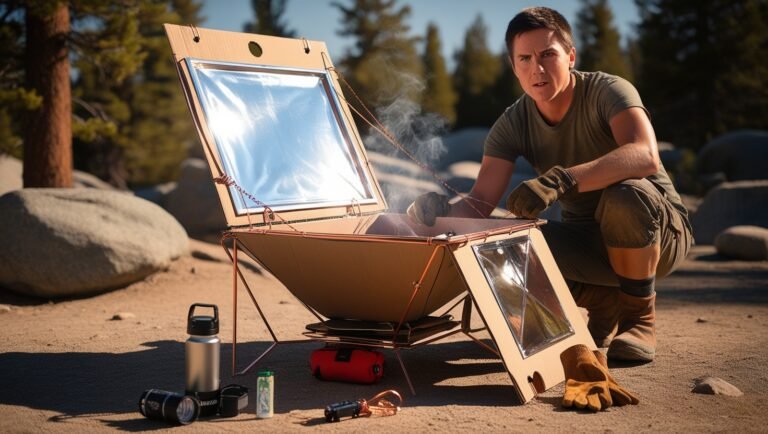
When I was hosting a summer barbecue, and the tantalizing aroma of grilled veggies and sizzling burgers fills the air. But there’s a twist – my outdoor kitchen is powered entirely by the sun! Did you know that solar-powered outdoor kitchens can reduce your energy bills by up to 30%?
In recent years, the concept of eco-friendly outdoor cooking has gained tremendous popularity among homeowners looking to combine their love for outdoor entertaining with environmentally conscious backyard design. Solar-powered outdoor kitchens represent the pinnacle of this trend, offering a perfect blend of functionality, sustainability, and modern aesthetics.
In this comprehensive guide, we’ll explore the exciting world of solar-powered outdoor kitchens and why they’re becoming the hottest trend for eco-conscious homeowners.

What Are Solar-Powered Outdoor Kitchens?
At its core, a solar-powered outdoor kitchen is a cooking and dining area that harnesses the power of the sun to operate its appliances and features. This sustainable backyard kitchen concept integrates solar panel technology into the design of traditional outdoor cooking spaces, creating an energy-efficient outdoor appliance system that reduces reliance on the grid.
The key components of a solar-powered outdoor kitchen system typically include:
- Solar panels: These are usually installed on the roof of the outdoor kitchen structure or nearby, capturing sunlight and converting it into usable electricity.
- Battery storage: To ensure consistent power even when the sun isn’t shining, most systems incorporate battery storage to save excess energy for later use.
- Inverter: This device converts the DC power generated by the solar panels into AC power that can be used by standard kitchen appliances.
- Energy-efficient appliances: Specially designed outdoor kitchen equipment that operates on solar power, including refrigerators, grills, and lighting.
- Control system: A central hub that manages power distribution and monitors energy usage across the outdoor kitchen.
By combining these elements, solar-powered outdoor kitchens offer a unique solution for those seeking to create sustainable outdoor living spaces without compromising on functionality or style.
Benefits of Solar-Powered Outdoor Kitchens
The advantages of integrating solar energy outdoor kitchen systems into your backyard go far beyond just being a trendy addition to your home. Let’s explore the numerous benefits that make these eco-friendly outdoor cooking spaces so appealing:

1. Environmental Impact and Sustainability
By harnessing renewable energy for outdoor cooking, solar-powered kitchens significantly reduce your carbon footprint. This eco outdoor kitchen layout eliminates the need for fossil fuels or grid electricity, making it an environmentally friendly outdoor entertaining option. As climate change concerns grow, adopting such green outdoor kitchen innovations demonstrates a commitment to sustainable living.

2. Cost Savings on Energy Bills
While the initial investment in solar outdoor kitchen equipment may be higher than traditional setups, the long-term savings are substantial. By generating your own power, you’ll see a noticeable decrease in your monthly energy bills. Some homeowners report savings of up to 30% on their overall energy costs after installing a solar-powered outdoor kitchen.

3. Increased Property Value
Sustainable outdoor kitchen design ideas are increasingly sought after in the real estate market. A well-designed solar-powered outdoor kitchen can significantly boost your home’s value, making it an attractive feature for potential buyers who prioritize eco-friendly living spaces.
4. Off-Grid Cooking Capabilities
One of the most exciting aspects of solar outdoor living is the ability to cook and entertain regardless of power outages or your proximity to the electrical grid. This makes solar-powered outdoor kitchens ideal for remote properties or areas prone to blackouts.
5. Reduced Reliance on Traditional Power Sources
By generating your own clean energy, you decrease your dependence on fossil fuels and centralized power grids. This not only contributes to a more sustainable future but also provides a sense of energy independence and self-sufficiency.

Designing Your Solar-Powered Outdoor Kitchen
Creating the perfect solar-powered outdoor kitchen requires careful planning and consideration. Here are some key factors to keep in mind when designing your eco outdoor kitchen layout:
Layout Considerations for Optimal Solar Exposure
To maximize the efficiency of your solar panels, it’s crucial to position your outdoor kitchen in an area that receives ample sunlight throughout the day. Consider the following:
- Analyze sun patterns in your backyard to identify the best location for solar panel placement.
- Avoid areas with heavy shade from trees or nearby structures.
- Consider adjustable or tracking solar panels to follow the sun’s movement for maximum energy capture.
Essential Appliances and Their Solar Power Requirements
When selecting energy-efficient outdoor appliances for your solar kitchen, consider their power consumption and how it aligns with your solar system’s capacity. Some popular eco outdoor cooking equipment options include:
- Solar-powered refrigerators and coolers
- Solar ovens and grills
- Energy-efficient induction cooktops
- Solar-powered lighting options
- Low-energy water pumps for sinks
Aesthetics and Integration with Existing Outdoor Spaces
Your solar-powered outdoor kitchen should seamlessly blend with your overall backyard design. Consider these sustainable outdoor kitchen design ideas:
- Use eco-friendly outdoor kitchen materials like reclaimed wood or recycled composite decking.
- Incorporate living walls or vertical gardens to enhance the green aesthetic.
- Choose energy-efficient outdoor kitchen lighting that complements your solar theme.
- Integrate your solar panels into the kitchen structure’s roof or nearby pergola for a sleek look.

Storage Solutions for Solar Equipment
Proper storage is essential for protecting your solar outdoor kitchen equipment and maintaining its efficiency:
- Design weatherproof cabinets to house batteries and inverters.
- Create dedicated spaces for storing portable solar panels when not in use.
- Include lockable storage for expensive solar-powered appliances.
Top Solar-Powered Appliances for Outdoor Kitchens
The heart of any kitchen lies in its appliances, and solar-powered outdoor kitchens are no exception. Here’s a rundown of some top-performing solar outdoor kitchen equipment to consider:
1. Solar-Powered Refrigerators and Coolers
Keep your beverages and perishables cold without tapping into the grid. Modern solar refrigerators are highly efficient and can run for days on stored solar energy.
CLICK TO SEE THE BEST SOLAR-POWERED REFRIGERATORS
2. Solar Ovens and Grills
Solar-powered ovens are eco-friendly, portable cooking devices that harness sunlight to bake, roast, and boil food, offering an energy-saving and versatile solution for outdoor cooking, ideal for camping and slow-cooked meals.
3. Solar-Powered Lighting Options
Solar-powered lighting options provide energy-efficient, eco-friendly solutions for outdoor spaces, utilizing solar panels to store sunlight during the day and power LED lights at night, making them perfect for gardens, pathways, camping, and remote areas without electricity.
4. Energy-Efficient Sinks and Water Heaters
Energy-efficient sinks and water heaters are designed to reduce water and energy consumption by using advanced technologies like low-flow faucets, tankless water heaters, and solar-powered systems, providing sustainable solutions for homes and outdoor setups while lowering utility costs perfect for very body
By choosing these solar-powered and energy-efficient appliances, you’ll create a fully functional outdoor kitchen that operates entirely on renewable energy.

Installation Process and Considerations
Installing a solar-powered outdoor kitchen requires careful planning and execution. Here’s an overview of the process:
1. Site Assessment and Planning
- Conduct a solar site assessment to determine the best location for your outdoor kitchen and solar panels.
- Calculate your energy needs based on the appliances and features you plan to include.
- Obtain necessary permits and check local building codes and homeowners’ association rules.
2. Solar Panel Placement and Configuration
- Choose between fixed or adjustable solar panel mounts.
- Determine the optimal angle and orientation for maximum sun exposure.
- Consider integrating panels into the kitchen structure or nearby pergola for a seamless look.
3. Battery Storage Options
- Select a battery system that can store enough energy for nighttime and cloudy day use.
- Consider lithium-ion batteries for their longevity and efficiency.
- Ensure proper ventilation and protection for your battery storage area.
4. Hiring Professionals vs. DIY Installation
While some aspects of building a solar-powered outdoor kitchen can be DIY projects, it’s generally recommended to work with professionals for:
- Electrical work and solar panel installation
- Plumbing for sinks and water features
- Structural elements of the kitchen
DIY enthusiasts can potentially handle tasks like:
- Building countertops and storage units
- Installing solar-powered lighting
- Setting up portable solar appliances
Always prioritize safety and consult with experts when in doubt.
Maintenance and Care for Solar-Powered Outdoor Kitchens
To ensure your solar outdoor kitchen continues to operate efficiently, regular maintenance is key:
Routine Cleaning and Upkeep of Solar Panels
- Clean solar panels every 6-12 months, or more frequently in dusty areas.
- Use a soft brush and mild soap solution to remove dirt and debris.
- Check for any damage or wear on the panels and supporting structures.
Winterizing Your Outdoor Kitchen
- Drain water lines and winterize plumbing to prevent freezing.
- Cover or store portable solar appliances indoors during harsh weather.
- Adjust solar panel angles to optimize for lower winter sun, if applicable.
Troubleshooting Common Issues
- Monitor battery performance and replace when efficiency decreases.
- Check electrical connections periodically for corrosion or loose fittings.
- Keep an eye on inverter performance and replace if necessary.
Upgrading and Expanding Your System
As technology advances, consider:
- Upgrading to more efficient solar panels or batteries.
- Adding new solar-powered appliances to your kitchen.
- Expanding your solar system to power other outdoor living areas.

Cost Analysis: Solar-Powered vs. Traditional Outdoor Kitchens
Understanding the financial implications of installing a solar-powered outdoor kitchen is crucial for making an informed decision:
Initial Investment Comparison
Solar-powered outdoor kitchens typically have a higher upfront cost due to the solar equipment. On average, expect to invest:
- Traditional outdoor kitchen: $5,000 – $20,000
- Solar-powered outdoor kitchen: $10,000 – $30,000+
Long-Term Savings and ROI
Despite the higher initial cost, solar kitchens offer significant long-term savings:
- Reduced or eliminated energy bills
- Increased home value (typically 3-4% for solar installations)
- Potential earnings from selling excess power back to the grid
Available Tax Incentives and Rebates
Many regions offer financial incentives for solar installations:
- Federal Investment Tax Credit (26% of system costs for 2022)
- State and local rebates and tax exemptions
- Solar Renewable Energy Credits (SRECs) in some states
Financing Options for Solar-Powered Outdoor Kitchens
Several financing options are available to make solar kitchens more accessible:
- Home equity loans or lines of credit
- Solar-specific loans from manufacturers or installers
- Power Purchase Agreements (PPAs) or solar leases
Mountain Retreat Goes Off-Grid
A remote cabin owner installed a solar kitchen to enjoy modern conveniences without connecting to the grid. The system powers a refrigerator, induction cooktop, and water pump, making off-grid living comfortable and eco-friendly.
Beachside Solar Kitchen
A coastal homeowner integrated a solar kitchen into their existing deck, powering a grill, blender for cocktails, and cooler. The saltwater-resistant panels have withstood years of ocean spray while providing reliable power for beach parties.
Future Trends in Solar-Powered Outdoor Cooking
As technology continues to advance, we can expect exciting developments in solar-powered outdoor kitchens:
Emerging Technologies in Solar Power Efficiency
- Bifacial solar panels that capture sunlight from both sides
- Perovskite solar cells with higher efficiency and lower production costs
- Transparent solar panels that can be integrated into windows or glass surfaces
Smart Home Integration Possibilities
- AI-powered energy management systems optimizing power usage
- Voice-controlled solar appliances for hands-free cooking
- Integration with home automation systems for seamless indoor-outdoor living
Predictions for the Outdoor Kitchen Industry
- Increased adoption of solar-powered kitchens in mainstream home design
- Development of more specialized solar cooking appliances
- Growth in modular, plug-and-play solar kitchen systems for easy installation
Conclusion
As we’ve explored in this comprehensive guide, solar-powered outdoor kitchens are not just a passing trend – they’re a sustainable, cost-effective, and stylish solution for the modern homeowner. By harnessing the power of the sun, you can create an eco-friendly culinary oasis right in your backyard that not only reduces your carbon footprint but also enhances your outdoor living experience.
From energy-efficient appliances and innovative designs to long-term cost savings and increased property value, the benefits of solar-powered outdoor kitchens are clear. As technology continues to advance and more homeowners prioritize sustainable living, we can expect these sun-powered cooking spaces to become an increasingly common sight in backyards and across the globe.
Ready to take your outdoor entertaining to the next level? Consider consulting with a solar energy specialist and outdoor kitchen designer to create the perfect sustainable backyard kitchen that meets your needs and aligns with your eco-conscious values.
Frequently Asked Questions (FAQs)
To address some common queries about solar-powered outdoor kitchens, we’ve compiled this list of frequently asked questions:
1. How much does a solar-powered outdoor kitchen cost?
The cost of a solar-powered outdoor kitchen can vary widely depending on size, features, and location. On average, you can expect to invest between $15,000 to $50,000+. This includes the cost of solar panels, batteries, inverters, and energy-efficient appliances. While the initial investment is higher than traditional outdoor kitchens, the long-term energy savings and increased property value often offset the cost over time.
2. Can I use my solar-powered outdoor kitchen at night or on cloudy days?
Yes! Most solar-powered outdoor kitchens include battery storage systems that store excess energy generated during sunny periods. This allows you to use your kitchen even when the sun isn’t shining. The size of your battery system will determine how long you can operate without direct sunlight.
3. What maintenance is required for a solar-powered outdoor kitchen?
Maintenance for solar-powered outdoor kitchens is relatively minimal. Regular tasks include:
- Cleaning solar panels every 6-12 months
- Checking and cleaning gutters and drains to prevent water damage
- Inspecting electrical connections annually
- Monitoring battery performance and replacing when necessary (usually every 5-10 years)
- Regular cleaning and maintenance of kitchen appliances as you would with any outdoor kitchen
4. Can I integrate a solar-powered kitchen into my existing outdoor living space?
Absolutely! Solar-powered kitchens can be designed to complement and integrate with existing outdoor spaces. You can retrofit solar panels onto existing structures or design new elements that incorporate both functional and energy-generating features. Working with a professional designer can help ensure a seamless integration.
5. What happens if there’s an extended period of bad weather?
Most solar-powered systems are designed with backup options in mind. This could include:
- Oversized battery storage to provide power for several days without sun
- Hybrid systems that can switch to grid power when necessary
- Portable solar panels that can be positioned to catch any available sunlight
Additionally, many homeowners choose to keep a small propane tank on hand for backup cooking options during extended periods of inclement weather.
6. Are solar-powered appliances as effective as traditional ones?
Modern solar-powered appliances have come a long way in terms of efficiency and performance. Many are designed to operate at levels comparable to their traditional counterparts. However, it’s important to choose appliances specifically designed for solar power use, as they are optimized for lower energy consumption and can function effectively with the varying power levels provided by solar panels. This ensures that the appliances perform reliably even when sunlight is inconsistent, maximizing energy efficiency and extending battery life in off-grid or outdoor setups.



